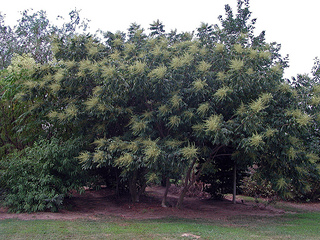Resource Library
Plant of the Week: Sumac, Chinese (‘September Beauty’)
The University of Arkansas System Division of Agriculture does not promote, support or recommend plants featured in "Plant of the Week." Please consult your local Extension office for plants suitable for your region.
Plant of the Week
‘September Beauty’ Chinese Sumac
Latin: Rhus chinensis

With the exception of crape myrtles, spring is the season of bloom for trees in Arkansas gardens. Anything flowering outside of the traditional blooming season, possibly because the heat of summer has just worn us down, seems to be pretty much ignored by gardeners. The fall blooming September Beauty Chinese sumac (Rhus chinensis) could change that as it becomes better known.
Chinese sumac is a 20-foot tall and wide deciduous tree of the cashew family that is widely distributed in East Asia from Malaysia to Korea, including China where it is the most widely distributed of the four species native there. Sumacs are native throughout the tropics and warm temperate regions of the world with over 250 species described, the largest number of which are found in Africa. North America has about 20 species.
It has the typical pinnately compound leaves of sumacs that grow from 8 to 15 inches long with 7 to 13 leaflets. The midrib of the leaf is winged. The upper leaf surface is bright green while the undersurface is covered with a light brownish pubescence. Fall color for September Beauty is an apricot yellow.
The most spectacular display associated with September Beauty Chinese sumac is its massive display of blooms in late summer and early fall. The cream-colored drooping, triangular panicles are to 18 inches long and a foot across and composed of a mass of tiny individual blooms. Sumacs are dioecious, meaning individual plants are either male or female. I could not find a source describing the sex of September Beauty, though I suspect it is a male plant. Regardless of its sex, don’t expect to see the typical cone of rusty red berries on September Beauty because it takes both male and female plants to make berries.
From an ethno-botanical standpoint, the nutgall tree as it is known in China, is an important plant where the aphid induced galls produced by the plant are an important part of traditional Chinese medicine. The galls are a rich source of gallotannins, biologically active compounds with strong antiviral, antibacterial and antioxidant properties. It is traditionally used to treat diarrhea, dysentery and coughs.
September Beauty was selected by Dr. Elwin Orton, Jr. of Rutgers University in the
1980s for its especially large panicle size. It is the only Chinese sumac commonly
offered in the nursery trade though sometimes it is offered as if it were the straight
species, not Orton’s selection.
September Beauty Chinese sumac is usually rated as hardy from zone 5 through 8, although
it can probably be grown farther south. Zone 5 is its northern limit and during especially
cold winters it may experience some top dieback in northern locations.
The tree is low-branched and broad spreading, making it tempting to use in the shrub border. This temptation should be resisted because, like all sumacs, it spreads by underground runners. Instead, plant it in full sun in a lawn situation where the mower will keep any unwanted suckers from developing. Once established, it is very drought tolerant. The gall-forming aphid is not found in this country.
By: Gerald Klingaman, retired
Retired Extension Horticulturist - Ornamentals
Extension News - June 7, 2013
The University of Arkansas System Division of Agriculture does not maintain lists of retail outlets where these plants can be purchased. Please check your local nursery or other retail outlets to ask about the availability of these plants for your growing area.